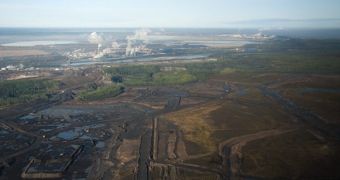New in-situ bitumen extraction techniques currently employed in the Canadian province of Alberta are far more damaging to the environment than previous methods, even if they cause less visible damage on the surface. Analysts cannot seem to agree on which type of extraction is the best.
The issue with the oil deposits in Alberta is that they come as bitumen, a compound that can usually be found in few natural deposits. However, it is plentiful in most crude petroleums. In these specific deposits, the pitch is trapped inside rocks and sands.
Extracting it is not as easy as building a rig. At this point, companies exploiting the deposits use either strip mining, or in-situ digs. The former has been the symbol of environmental destruction for years.
Strip mining revolves around cutting down the forests above the deposits, and then literally taking the ground off them. Huge trucks then haul out raw amounts of the petroleum-rich sands, for processing at a different location. This approach produces numerous toxic lakes filled with cyanide.
But the newest approaches are far more damaging in the long run, experts agree. They say that these methods revolve around using large pipes to inject massive amounts of Steam straight into the deposits. This helps companies reach deeper concentrations than possible with strip mining.
Once in the deposit, the steam liquefies the tar on the spot. The liquid then flows through a series of pipes, and is collected at a central installation. On the surface, the environment is undisturbed, with only the occasional pipe running into the ground.
However, in the long run, this approach has much more severe consequences. The process is extremely energy-intensive, requiring vast amounts of fossil fuels to be burnt in order to complete it successfully.
This in turn triggers the release of vast amounts of carbon dioxide into the atmosphere. It is currently estimated that as much as 2.7 percent of the entire Canadian greenhouse gas emission total is account for by the steam used to flush out bitumen.
In 2010, a total of 19 megatons of carbon dioxide were released into the atmosphere as a result of using this process alone. Analysts say that this amount of carbon is the equivalent of emissions released by 3.7 million cars over an entire year, Technology Review reports.
Sadly, the Canadian government is unlike to take any steps to address this issue. Most of Alberta is now reliant on income generated by oil exploitations. Last year, Canadian and international companies invested a total of $13 billion in exploiting the province's oil deposits.

 14 DAY TRIAL //
14 DAY TRIAL //